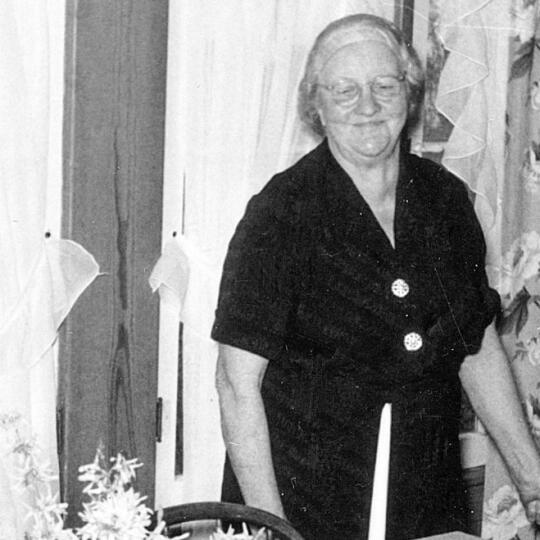This continues a series adapted from the book, “A Port Oneida Collection,” Volume 1 of the twopart set, “Oral History, Photographs, and Maps from the Sleeping Bear Region,” produced by Tom Van Zoeren in partnership with Preserve Historic Sleeping Bear. Here we continue with a look at the old Fred & Ellen Miller Farm, just north of the Thoreson Farm at the north end of Thoreson Road, focused here on Ellen Miller, innkeeper of the Manitou View Inn built there by her husband Fred: The Millers’ next-door neighbors, the Watkins family, were “summer people” from Chicago. They remembered Mrs. Miller “like a third grandmother. She gave us cake and flowers. She had us over for dinner; she prepared beautiful dinners. To us she was just this lovely grandmother.” Mary Watkins Crane recalls, “Mrs. Miller had a wood stove. It was amazing that she could produce all those wonderful meals without a six-burner range and two ovens. I remember lots of wood going in but I have no idea where it came from. An amazing woman, Ellen Olsen Miller seemed to be able to do everything. Her house was always spotless as was she herself. I never saw her in a dirty apron. There was no sand on her floors despite all those guests marching through. Sheets and towels appeared on the line. White throw rugs looked like they had just been put down. And always, always, Mrs. Miller seemed to be in a clean dress and smell like soap.”
At the same time, Mrs. Miller was a fierce defender of her property. Grandson Bob Adair recalls that she “had it in” for her old schoolmate next door: “‘That red-headed devil,’ Ole Thoreson, seemed to, in my Grandmother’s eyes, be responsible for every act of nature, both real and imagined, that happened out there—and I don’t know why.”
The Watkins sisters continued, “People were afraid of her.” Some got along with her, “but it was like walking on eggs. She was very nice if you gave her credit . . . But in the spring when the storms would loosen up the shingles on the roof, she’d say, ‘Oh, Ole Thoreson has been prying up my shingles.’ He was portrayed as an evil person, but we knew better because we knew him ourselves.”
The Miller marriage is remembered as something like one of those Lake Michigan storms. After it ended with Fred moving to Traverse City, and then to Wisconsin, Ellen was “on the outs” with the remaining Millers and others. Many stories were told; of course, there is no way of knowing any longer which might be true.
Leonard Thoreson remembers a reported sighting of Ellen chasing Fred around the barn with a yoke (the heavy club-like member used to connect a team of horses). Neighbor George Burfiend recalls a story about the spring planting of the Millers’ garden: “She had a drawing of her garden—and she wanted lettuce here, and peas here, radishes here, and so on & so on; and she gave him all these sacks of seeds and talked to him about it. So he said, ‘Oh yeah, yeah, yup.’ So he went out there, and he got a bucket, and he just dumped all the seeds in the bucket and stirred it up, and broadcast them, and left.”
After the inn burned down around 1932, one of the Millers’ Port Oneida neighbors reported seeing Mrs. Miller digging her washing machine out of the hay mow in the barn. This led to suspicion around the community that she had stashed the washer for safe-keeping, then torched the place. Why would she do such a thing? “Probably got mad at Fred, I suppose,” was her nephew Charlie Miller’s explanation.
Grandson Bob Adair discounts the arson theory, though, noting, “There wasn’t dime-one of insurance. There was no reason to burn it.” Ellen always said the fire was started by a lightning strike. As Bob points out, this would help explain her terrible fear of storms.
Granddaughter Paula Jones remembered Ellen as “always very dramatic.” She would get into a disagreement with her daughter Leone, and would announce that she was going to “throw herself over the cliff” behind the house—then would go back there and wait for Leone to come and make up. ~~~ Ellen’s old inn/house was eventually adopted as home by her daughter Leone and Leone’s husband Ed Adair. Mr. Adair was a retired history teacher who loved to instruct anyone available in the history of the surrounding country. In his later years he loved to wander and visit old barns and other favorite haunts on his riding lawn mower. Park Rangers in the early days of the National Lakeshore occasionally caught him driving Park hiking trails on it (but never had the heart to ticket him). Once he had Leone worried after being gone for hours. A search operation was mounted by the Rangers. Ed was finally found to have driven his riding mower to Art’s Tavern in Glen Arbor. ~~~ Ellen’s old home and surroundings remain as private inholdings in the National Lakeshore, owned by helpful supporters of the park and this project. ©tvz









